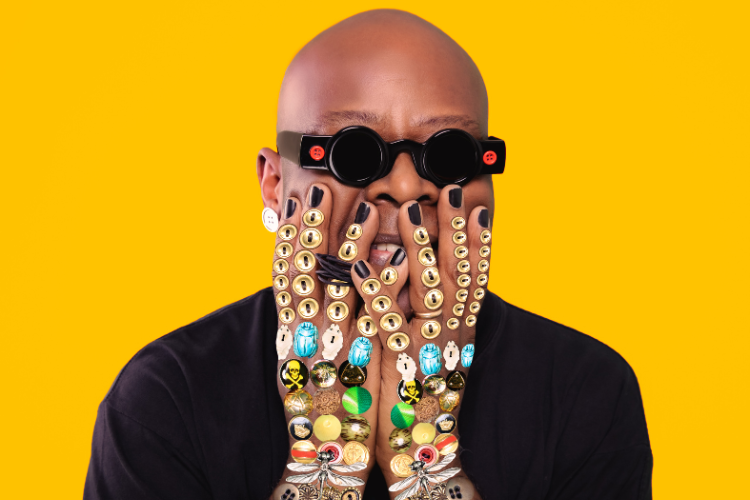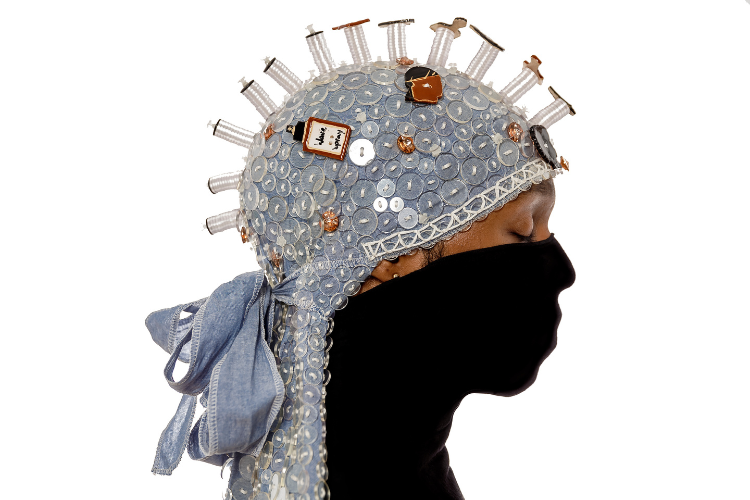A Conversation with Harlem's Beloved 'Button Man' Beau McCall
The Philadelphia-born, Harlem-based artist discussed his creative journey and how the Uptown community has influenced his work.

Uptown-based creative visionary Beau McCall—artistically known as The Button Man—was immersed in the spirit of Harlem before even stepping foot in the neighborhood. While growing up, his South Philadelphia apartment was often filled with the vinyl sounds of Dinah Washington, Billie Holiday, Dizzy Gillespie, and other greats who were synonymous with the community’s cultural renaissance.
“Most of the people my parents listened to had some kind of connection to Harlem, whether they lived there or played at mainstays like the Savoy or the Apollo where jazz musicians honed their craft,” said McCall, who has lived in Harlem since the late '80s, told Columbia Neighbors.
Now McCall, who works at the intersection of arts and fashion, is leading a renaissance of his own with buttons at the center of it all. He uses the tiny fasteners as time capsules that encapsulate his early creative influences, cherished memories, and life lessons—inspiring people to discover the beauty in everyday things. Columbia Neighbors spoke with McCall about his creative journey, how the Harlem community has influenced his work, and his upcoming exhibition at the Fuller Craft Museum in Brockton, Massachusetts.
How did your childhood influence your path in the arts?
My mother was a creative and she liked decorating. She used to go to thrift shops, rummage sales, and junk shops before upcycling was an actual trend. During this period of time, my brother and I would be embarrassed to go to some of these places, but then I realized she was curating the things she would select to decorate our apartment. I watched her selections. I watched her color palette. The things she was choosing were not commonly used in decorating and that stood out to me.
Every summer, my brother and I would get a new pair of Keds sneakers. I’d cut the top off of the old ones, rip the inside out, and weave telephone wires into the sneakers to make them unique. It was the first inkling of talent I discovered within myself. That creative exploration showed me I had some type of artistic offering. Every couple of months, I would explore a different art form, going from macramé to papier-mâché. I kept creating until I settled on what I wanted to do.
When was the first time you saw yourself reflected in the art space?
I grew up in public housing in South Philadelphia and through after-school and summer programs we would go to all of the local museums. Although I was hooked on going to the museums, at that point in time I hadn’t seen my reflection in the work. Even the artwork my mom chose for the house were copies of Picasso and Modigliani. It wasn’t until I came to New York as an adult that I started discovering other artists and works of people who looked like me in the work. After I started seeing myself reflected, it made me believe I could make a path for myself and create work that mirrored my own images and experiences.
After I started seeing myself reflected, it made me believe I could make a path for myself and create work that mirrored my own images and experiences.
What inspired you to use buttons as an artistic medium? Can you share some insight into the role buttons have played within Black history and culture?
Culturally, everybody’s mother, grandmother, auntie, or somebody in their family had a jar, a cookie tin can, or a cigar box of buttons. That's how it was within my family. Buttons are valuable, practical, and smaller for storage. For me, the button itself has a language that helps me speak within my creations. There are so many historical connections across the diaspora. In the early 19th century, buttons were used as identifiers for those who were enslaved. In the Congo, this elite group called the Bwami would adorn their creations with buttons. Buttons were also used for memory jugs. When a person died, they would collect the buttons off of their garments and put them in a jar for keepsakes.

A lot of your pieces artistically address social justice issues. How can fashion and art be used as means for activism?
Fashion, art, and music are all intertwined. All three areas allow you to have a voice within the work. I knew early on I wanted to be an artist because as someone who was shy in nature and very introverted, I would be able to let the artwork speak for itself. As I progressed in the art space that didn’t last for long. People started to inquire about the meaning and the vision behind my work. Speaking up and sharing my vision inspired me to use my voice.
I have a piece called World Spinning on a 45 that was inspired by a song called “We the People” by the Staples Singers. It features a yellow apparatus that you stick in a 45 record to make it spin. The vision behind that was to illustrate how music has the power to speak to people and bridge cultures together despite our differences.
I also did a series of collages called REWIND: MEMORIES ON REPEAT. It’s about all of my deceased friends who didn’t make it as far as I’ve made it. In the work, through these collages, I capture how they had an impact on my life. Some of them I lost to AIDS, some of them to other health issues like diabetes, and some of them to suicide, and murder—things that have all impacted our society. I’m the only one standing to tell our stories. To me the power of art is storytelling.
What inspired you to move to Harlem? What would you say are some of the parallels between Philadelphia and Harlem?
One of the major similarities is the sense of community. In Philly, everyone is connected in some sort of way. It’s like an interlocked family. When I got to Harlem, it was the same thing. It was very easy to move around. All the people looked familiar. It looked like it was an extension of where I came from. Harlem is familiar. It’s like Cheers. Even if you don’t know the people by their names, you know their physical appearance. I’ve seen people over the years who I’ve never talked to, but we’ve been in the same spaces and I’m comfortable in the spaces with those people. It’s like we have some kind of unspoken kinship that is comforting. I have met strangers on the street who will pop a button off their clothes and say “Oh, you’re The Button Man. Here take this. You’ll need it.”
Growing up, my parents primarily played jazz in our household. I was very fascinated with the fact that I could walk on the same ground as Dinah Washington, Billie Holiday, Miles Davis, and Dizzy Gillespie. These are all of the people I grew up listening to. I wanted to come here and leave my own mark so that 50 or 100 years from now someone could say “Beau McCall used to live in Harlem.”
I’m where I want to be, I’m where I need to be. Harlem is my safe place. As far as my creativity, I found a place for exploration and enlightenment. All of the things I’m inspired by are right here in the community. I don’t have to go downtown. I’m in the culture.
Harlem is familiar...It’s like we have some kind of unspoken kinship that is comforting.
Can you share the inspiration behind your upcoming exhibition Beau McCall: Buttons On! at the Fuller Craft Museum?
It’s been a long time coming. I’ve been in the creative industry for over forty years, and I feel like I’ve been under the radar. The work reflects my life journey; whether it was the chapter of moving from Philadelphia to New York or just vibing around the Harlem energy and culture. I hope this exhibition gives gallery-goers a lens into who I am as a person. I hope it piques their interest, sparks their own creativity, and shows them how something as simple as a little tiny button that we take for granted on a daily basis can be used as a way to communicate. I want them to walk away inspired.

Who or what are you inspired by?
People always ask me if it is other artists. It’s my mom. She is my biggest inspiration. In the house growing up, I don’t think my mother realized the power of her creativity. There are a lot of things she did on an everyday basis that still stick with me today. I’ve got a few techniques on how to utilize the button by just having our daily conversations. If I were to go home now, she would have bags and cans of buttons waiting for me. I never come back home without a bag of buttons that she sourced somewhere. My mom, along with my family members, and my life partner, Souleo are my biggest supporters.
What advice would you give to an aspiring artist?
The advice I would give to an aspiring artist is to stay focused. I was frustrated through a lot of different periods of creativity, but it never made me want to stop. Whether I had an audience or not, I continued to create. The reality of it all is that my creativity is for myself first, and then I share it with whoever is interested. I would tell a young person to hone their skills and get out and explore. Also, remember art is an ever-evolving process of transformation. I’m ready for this moment because I’ve had greater life experiences and I’m able to communicate them through my work better.